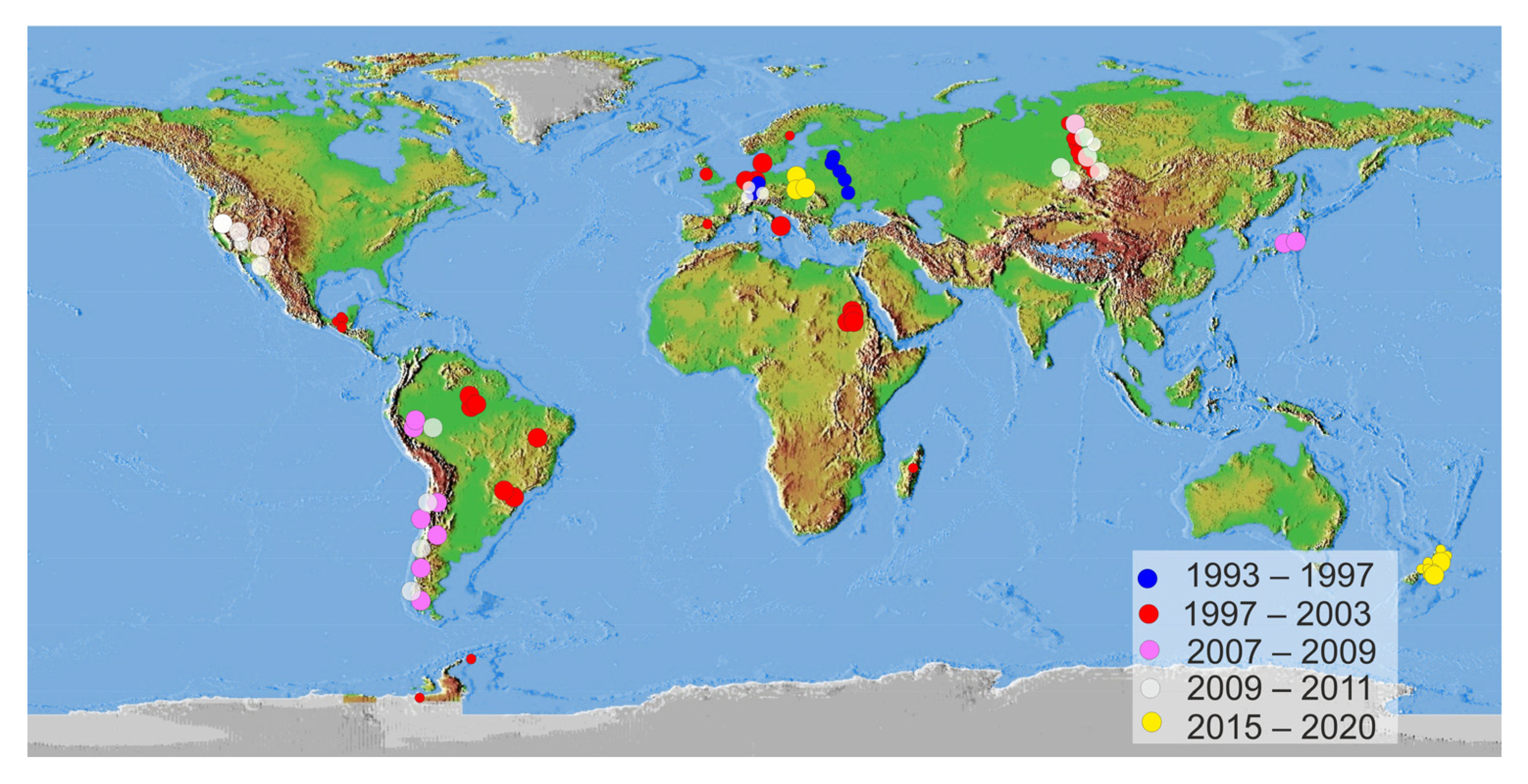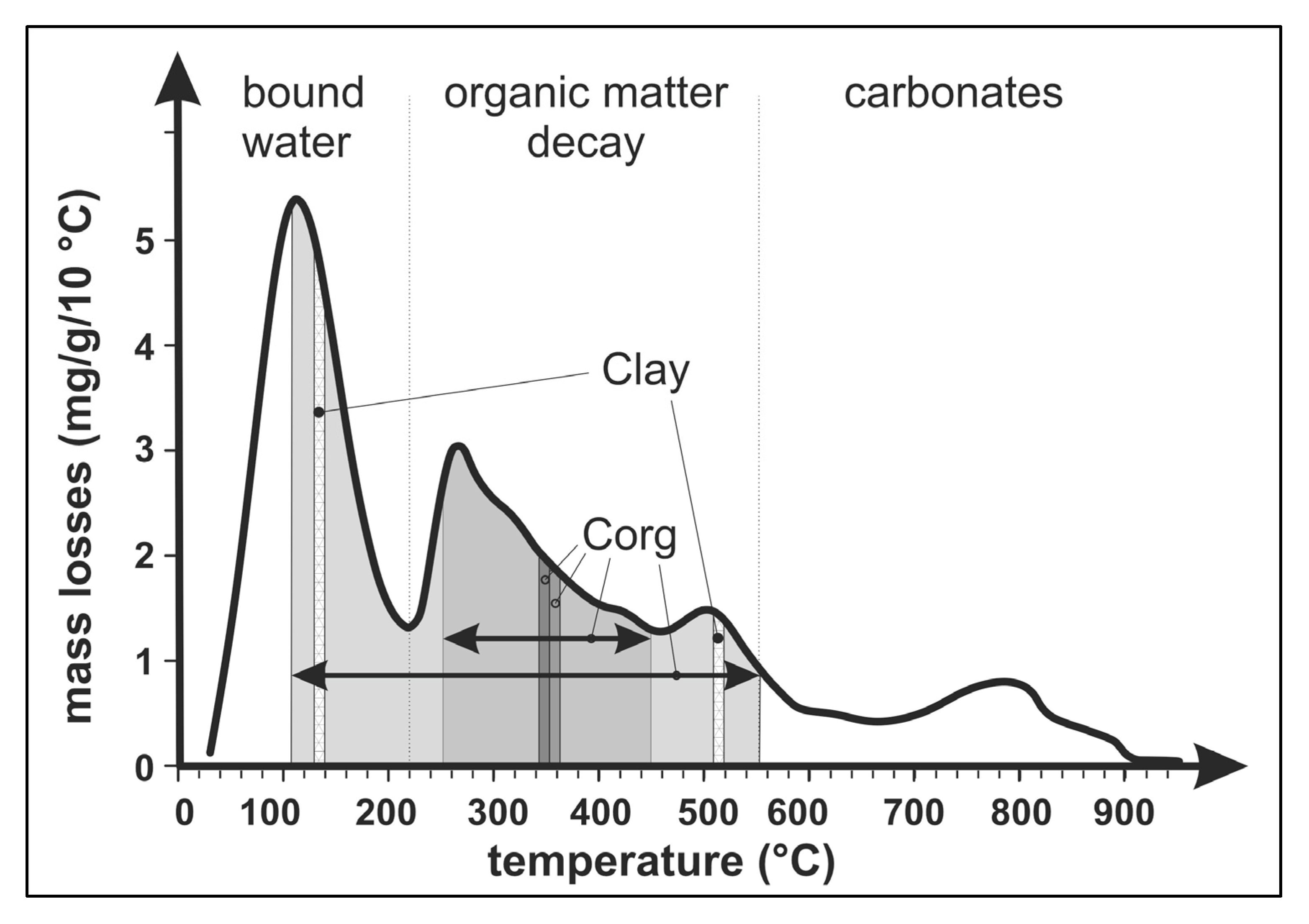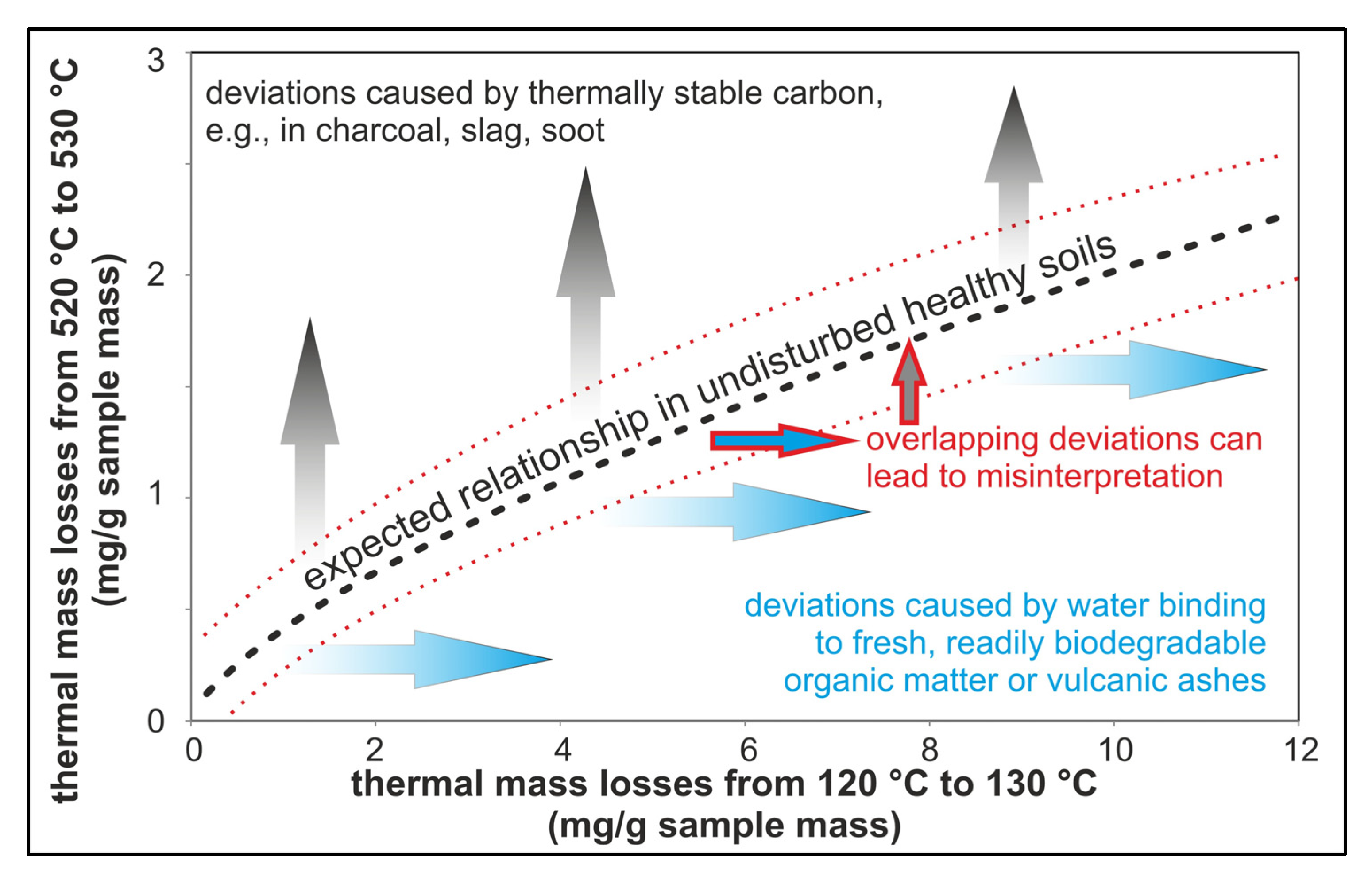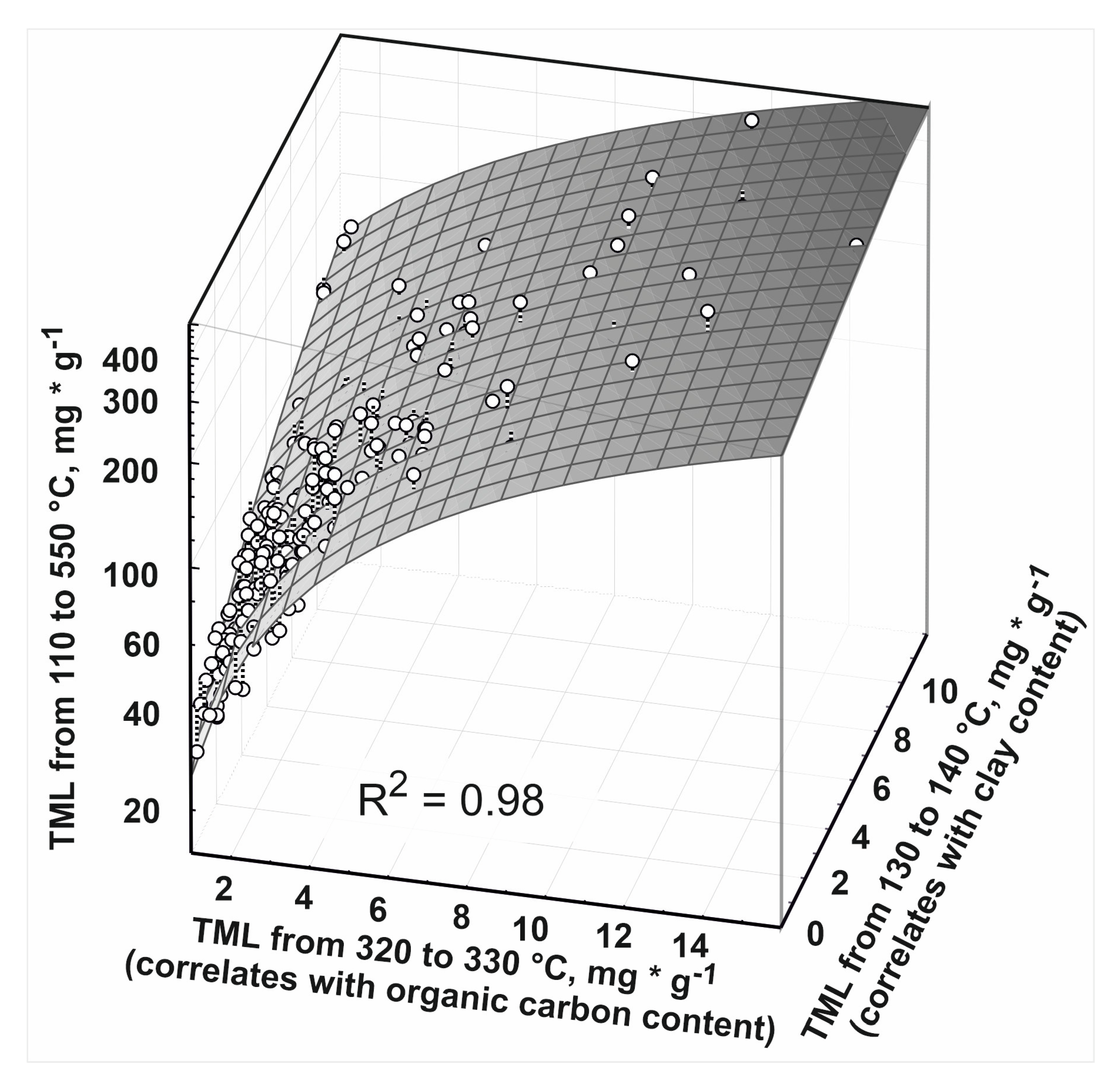New Approach to Experimental Soil Health Definition Using Thermogravimetric Fingerprinting
Abstract
1. Introduction: Challenges for Soil Health as a Base for Sustainable Land Use
2. Experimental Base
2.1. Sample Collection
2.2. The Methodical Approach
2.3. Sample Preparation and Used Methods
3. Thermal Decay Dynamics and Detectability of Relationships
4. Example Results for the Development of Soil Health Indicators
4.1. Soil Organic Matter and Clay-Dependent Thermal Mass Losses
4.2. Correlating Thermal Mass Losses with Carbon and Nitrogen Contents
4.3. Mass Loss on Ignition and Level of Organic Carbon Sequestration
5. Discussion
5.1. Importance of Sample Preparation
5.2. Origins of the Relationships Found Between Bound Water and Soil Components
5.3. Consideration of Naturalness in Soils
5.4. Challenges of Thermogravimetric Soil Analysis
5.5. Expected Benefits and Practical Application Perspectives
6. Conclusions
Author Contributions
Funding
Conflicts of Interest
Abbreviations
| C | carbon |
| CO2 | carbon dioxide |
| MLI | mass loss on ignition |
| N | nitrogen |
| OC | organic carbon |
| SOC | soil organic carbon |
| SOM | soil organic matter |
| TML | thermal mass losses |
References
- Montgomery, D.R. Dirt: The Erosion of Civilizations, with a New Preface; Univ of California Press: Berkeley, CA, USA, 2012. [Google Scholar]
- Blume, H.P. Some aspects of the history of German soil science. J. Plant Nutr. Soil Sci. 2002, 165, 377–381. [Google Scholar] [CrossRef]
- Amelung, W.; Blume, H.-P.; Fleige, H.; Horn, R.; Kandeler, E.; Wilke, B.-M. Scheffer/Schachtschabel. Textbook on Soil Science; Springer: Berlin/Heidelberg, Germany, 2018. [Google Scholar]
- Doran, J.; Sarrantonio, M.; Liebig, M.; Sparks, D. Soil health and sustainability. Adv. Agron. 1996, 56, 1–54. [Google Scholar] [CrossRef]
- Lehmann, J.; Bossio, D.A.; Kögel-Knabner, I.; Rillig, M.C. The concept and future prospects of soil health. Nat. Rev. Earth Environ. 2020, 1, 544–553. [Google Scholar] [CrossRef]
- Don, A.; Seidel, F.; Leifeld, J.; Kätterer, T.; Martin, M.; Pellerin, S.; Emde, D.; Seitz, D.; Chenu, C. Carbon sequestration in soils and climate change mitigation—Definitions and pitfalls. Glob. Chang. Biol. 2023, 30, e16983. [Google Scholar] [CrossRef]
- Nachtergaele, F.O.; Spaargaren, O.; Deckers, J.A.; Ahrens, B. New developments in soil classification: World reference base for soil resources. Geoderma 2000, 96, 345–357. [Google Scholar] [CrossRef]
- Bucka, F.B.; Guigue, J.; Reifschneider, L.; Pihlap, E.; Garcia-Franco, N.; Kühnel, A.; Kögel-Knabner, I.; Vidal, A. From waste to soil: Can we create functioning manufactured soils by recycling rock processing waste? Soil Use Manag. 2024, 40, e13094. [Google Scholar] [CrossRef]
- Prăvălie, R.; Borrelli, P.; Panagos, P.; Ballabio, C.; Lugato, E.; Chappell, A.; Miguez-Macho, G.; Maggi, F.; Peng, J.; Niculiță, M.; et al. A unifying modelling of multiple land degradation pathways in Europe. Nat. Commun. 2024, 15, 3862. [Google Scholar] [CrossRef]
- Blankinship, J.C.; Schimel, J.P. Biotic versus abiotic controls on bioavailable soil organic carbon. Soil Syst. 2018, 2, 10. [Google Scholar] [CrossRef]
- Wiesmeier, M.; Urbanski, L.; Hobley, E.; Lang, B.; von Lützow, M.; Marin-Spiotta, E.; van Wesemael, B.; Rabot, E.; Ließ, M.; Garcia-Franco, N.; et al. Soil organic carbon storage as a key function of soils-A review of drivers and indicators at various scales. Geoderma 2019, 333, 149–162. [Google Scholar] [CrossRef]
- Nunes, M.R.; Veum, K.S.; Parker, P.A.; Holan, S.H.; Karlen, D.L.; Amsili, J.P.; van Es, H.M.; Wills, S.A.; Seybold, C.A.; Moorman, T.B. The soil health assessment protocol evaluation applied to soil organic, C. Soil Sci. Soc. Am. J. 2021, 85, 1196–1213. [Google Scholar] [CrossRef]
- Fine, A.K.; van Es, H.M.; Schindelbeck, R.R. Statistics, Scoring Functions, and Regional Analysis of a Comprehensive Soil Health Database. Soil Sci. Soc. Am. J. 2017, 81, 589–601. [Google Scholar] [CrossRef]
- Svoray, T.; Hassid, I.; Atkinson, P.M.; Moebius-Clune, B.N.; van Es, H.M. Mapping Soil Health over Large Agriculturally Important Areas. Soil Sci. Soc. Am. J. 2015, 79, 1420–1434. [Google Scholar] [CrossRef]
- Bünemann, E.K.; Bongiorno, G.; Bai, Z.; Creamer, R.E.; De Deyn, G.; de Goede, R.; Fleskens, L.; Geissen, V.; Kuyper, T.W.; Mäder, P.; et al. Soil quality—A critical review. Soil Biol. Biochem. 2018, 120, 105–125. [Google Scholar] [CrossRef]
- Wessolek, G.; Kaupenjohann, M.; Dominik, P.; Ilg, K.; Schmitt, A.; Zeitz, J.; Gahre, F.; Ellerbrock, R.; Utermann, J.; Düwel, O.; et al. Ermittlung von Optimalgehalten an organischer Substanz landwirtschaftlich genutzter Böden nach § 17 (2) Nr. 7 BBodSchG. Forschungsprojekt im Auftrag des Umweltbundesamtes FuE-Vorhaben. Förderkennzeichen 2008, 202, 264. [Google Scholar]
- Riggers, C.; Poeplau, C.; Don, A.; Frühauf, C.; Dechow, R. How much carbon input is required to preserve or increase projected soil organic carbon stocks in German croplands under climate change? Plant Soil 2021, 460, 417–433. [Google Scholar] [CrossRef]
- Körschens, M.; Albert, E.; Armbruster, M.; Barkusky, D.; Baumecker, M.; Behle-Schalk, L.; Bischoff, R.; Čergan, Z.; Ellmer, F.; Herbst, F.; et al. Effect of mineral and organic fertilization on crop yield, nitrogen uptake, carbon and nitrogen balances, as well as soil organic carbon content and dynamics: Results from 20 European long-term field experiments of the twenty-first century. Arch. Agron. Soil Sci. 2013, 59, 1017–1040. [Google Scholar] [CrossRef]
- Ma, Y.; Woolf, D.; Fan, M.; Qiao, L.; Li, R. Global crop production increase by soil organic carbon. Nat. Geosci. 2023, 16, 1159–1165. [Google Scholar] [CrossRef]
- Lehmann, J.; Hansel, C.M.; Kaiser, C.; Kleber, M.; Maher, K.; Manzoni, S.; Nunan, N.; Reichstein, M.; Schimel, J.P.; Torn, M.S.; et al. Persistence of soil organic carbon caused by functional complexity. Nat. Geosci. 2020, 13, 529–534. [Google Scholar] [CrossRef]
- Lal, R. Challenges and opportunities in soil organic matter research. Eur. J. Soil Sci. 2009, 60, 158–169. [Google Scholar] [CrossRef]
- Lal, R. Soil health and carbon management. Food Energy Secur. 2016, 5, 212–222. [Google Scholar] [CrossRef]
- Maharjan, B.; Das, S.; Acharya, B.S. Soil Health Gap: A concept to establish a benchmark for soil health management. Glob. Ecol. Conserv. 2020, 23, e01116. [Google Scholar] [CrossRef]
- Lausch, A.; Blaschke, T.; Haase, D.; Herzog, F.; Syrbe, R.-U.; Tischendorf, L.; Walz, U. Understanding and quantifying landscape structure—A review on relevant process characteristics, data models and landscape metrics. Ecol. Model. 2015, 295, 31–41. [Google Scholar] [CrossRef]
- Hill, M.O.; Roy, D.B.; Thompson, K. Hemeroby, urbanity and ruderality: Bioindicators of disturbance and human impact. J. Appl. Ecol. 2002, 39, 708–720. [Google Scholar] [CrossRef]
- Van Breemen, N. Natural organic tendency. Nature 2002, 415, 381–382. [Google Scholar] [CrossRef]
- Siewert, C. Investigation of the Thermal and Biological Stability of Soil Organic Matter; Shaker: Aachen, Germany, 2001; ISBN 3-8265-9631-5. [Google Scholar]
- Siewert, C. Rapid scanning of soil properties using thermogravimetry. Soil Sci. Soc. Am. 2004, 68, 1656–1661. [Google Scholar] [CrossRef]
- Siewert, C.; Kučerík, J. Practical applications of thermogravimetry in soil science. Part 3: Interrelations between soil components and unifying principles of pedogenesis. J. Therm. Anal. Calorim. 2015, 120, 471–480. [Google Scholar] [CrossRef]
- Körschens, M.; Weigel, A.; Schulz, E. Turnover of soil organic matter (SOM) and long-term balances—Tools for evaluating sustainable productivity of soils. J. Plant Nutr. Soil Sci. 1998, 161, 409–424. [Google Scholar] [CrossRef]
- Howard, P.J.A.; Howard, D.M. Use of organic carbon and loss-on-ignition to estimate soil organic matter in different soil types and horizons. Biol. Fertil. Soils 1990, 9, 306–310. [Google Scholar] [CrossRef]
- Bojko, O.; Kabała, C. Loss-on-ignition as an estimate of total organic carbon in the mountain soils. Pol. J. Soil Sci. 2016, 47, 71. [Google Scholar] [CrossRef]
- Hoogsteen, M.J.J.; Lantinga, E.A.; Bakker, E.J.; Tittonell, P.A. An Evaluation of the loss-on-ignition method for determining the soil organic matter content of calcareous soils. Commun. Soil Sci. Plant Anal. 2018, 49, 1541–1552. [Google Scholar] [CrossRef]
- Jensen, J.L.; Christensen, B.T.; Schjønning, P.; Watts, C.W.; Munkholm, L.J. Converting loss-on-ignition to organic carbon content in arable topsoil: Pitfalls and proposed procedure. Eur. J. Soil Sci. 2018, 69, 604–612. [Google Scholar] [CrossRef] [PubMed]
- Ondruch, P.; Kučerík, J.; Tunega, D.; Silva, N.J.; Aquino, A.J.; Schaumann, G.E. Influence of water molecule bridges on sequestration of phenol in soil organic matter of sapric histosol. Environ. Chem. 2019, 16, 541–552. [Google Scholar] [CrossRef]
- Plante, A.F.; Fernández, J.M.; Leifeld, J. Application of thermal analysis techniques in soil science. Geoderma 2009, 153, 1–10. [Google Scholar] [CrossRef]
- Kučerík, J.; Demyan, M.S.; Siewert, C. Practical application of thermogravimetry in soil science. J. Therm. Anal. Calorim. 2016, 123, 2441–2450. [Google Scholar] [CrossRef]
- Tokarski, D.; Šimečková, J.; Kučerík, J.; Kalbitz, K.; Demyan, M.S.; Merbach, I.; Barkusky, D.; Ruehlmann, J.; Siewert, C. Detectability of degradable organic matter in agricultural soils by thermogravimetry. J. Plant Nutr. Soil Sci. 2019, 182, 729–740. [Google Scholar] [CrossRef]
- Tokarski, D.; Wiesmeier, M.; Weissmannová, H.D.; Kalbitz, K.; Demyan, M.S.; Kučerík, J.; Siewert, C. Linking thermogravimetric data with soil organic carbon fractions. Geoderma 2020, 362, 114–124. [Google Scholar] [CrossRef]
- Kučerík, J.; Siewert, C. Practical application of thermogravimetry in soil science. Part 2. Modeling and prediction of soil respiration using thermal mass losses. J. Therm. Anal. Calorim. 2014, 116, 563–570. [Google Scholar] [CrossRef]
- Doležalová-Weissmannová, H.; Malý, S.; Brtnický, M.; Holátko, J.; Demyan, M.S.; Siewert, C.; Tokarski, D.; Kameníková, E.; Kučerík, J. Practical applications of thermogravimetry in soil science: Part 5. Linking the microbial soil characteristics of grassland and arable soils to thermogravimetry data. J. Therm. Anal. Calorim. 2022, 148, 1599–1611. [Google Scholar] [CrossRef]
- Schiedung, M.; Don, A.; Wordell-Dietrich, P.; Alcántara, V.; Kuner, P.; Guggenberger, G. Thermal oxidation does not fractionate soil organic carbon with differing biological stabilities. J. Plant Nutr. Soil Sci. 2017, 180, 18–26. [Google Scholar] [CrossRef]
- Sokolov, D.; Dmitrevskaya, I.; Pautova, N.B.; Lebedeva, T.N.; Chernikov, V.; Semenov, V.M. A Study of Soil Organic Matter Stability Using Derivatography and Long-Term Incubation Methods. Eurasian Soil Sci. 2021, 54, 487–498. [Google Scholar] [CrossRef]
- Beyer, L.; Deslis, K.; Vogt, B. Estimation of soil organic matter composition according to a simple thermoanalytical approach. Commun. Soil Sci. Plant Anal. 1998, 29, 1277–1297. [Google Scholar] [CrossRef]
- Pallasser, R.; Minasny, B.; McBratney, A.B. Soil carbon determination by thermogravimetrics. PeerJ 2013, 1, e6. [Google Scholar] [CrossRef]
- Smidt, E.; Lechner, P. Study on the degradation and stabilization of organic matter in waste by means of thermal analyses. Thermochim. Acta 2005, 438, 22–28. [Google Scholar] [CrossRef]
- Siewert, C.; Zeitz, J. Considerations on the experimental differentiation of near-natural and utilised soils by means of thermogravimetry. Commun. Ger. Soil Sci. Soc. 2003, 102, 797–798. [Google Scholar]
- Tokarski, D.; Kučerík, J.; Kalbitz, K.; Demyan, M.S.; Merbach, I.; Barkusky, D.; Ruehlmann, J.; Siewert, C. Contribution of organic amendments to soil organic matter detected by thermogravimetry. J. Plant Nutr. Soil Sci. 2018, 181, 664–674. [Google Scholar] [CrossRef]
- Bölter, M.; Siewert, C.; Kuhn, D. Patterns of soil microbes and soil organic matter characteristics in a periglacial environment at King George Island (Maritime Antarctic). In Proceedings of the Symposium “Ecology of Antarctic Coastal Oasis”, Valtice, Czech Republic, 21–24 September 2001; Geographia 25. pp. 83–95. [Google Scholar]
- Wessolek, G.; Siewert, C. Diagnostik von Artefakten in der organischen Bodensubstanz. Mitteilungen Der Dtsch. Bodenkd. Ges. 2001, 96, 47–50. [Google Scholar]
- Elias, E.A.; Alaily, F.; Siewert, C. Characteristics of organic matter in selected profiles from the Gezira Vertisols as determinated by thermogravimetry. Int. Agrophysics 2002, 16, 269–275. [Google Scholar]
- Kučerík, J.; Svatoň, K.; Malý, S.; Brtnický, M.; Doležalová-Weismannová, H.; Demyan, M.S.; Siewert, C.; Tokarski, D. Determination of soil properties using thermogravimetry under laboratory conditions. Eur. J. Soil Sci. 2020, 71, 415–419. [Google Scholar] [CrossRef]
- Siewert, C. Method for Determining the Qualitative Composition of the Organic Soil Substance of Mineral Soils. US Patent 6,382,830 B1, 7 May 2002. [Google Scholar]
- Kučerík, J.; Tokarski, D.; Demyan, M.; Merbach, I.; Siewert, C. Linking soil organic matter thermal stability with contents of clay, bound water, organic carbon, and nitrogen. Geoderma 2018, 316, 38–46. [Google Scholar] [CrossRef]
- Maffia, M.C.; Meirelles, A.J. Water activity and pH in aqueous polycarboxylic acid systems. J. Chem. Eng. Data 2001, 46, 582–587. [Google Scholar] [CrossRef]
- Ferrer, I.; Thurman, E.M.; Zweigenbaum, J.A.; Murphy, S.F.; Webster, J.P.; Rosario-Ortiz, F.L. Wildfires: Identification of a new suite of aromatic polycarboxylic acids in ash and surface water. Sci. Total Environ. 2021, 770, 144661. [Google Scholar] [CrossRef] [PubMed]
- Liang, C.; Schimel, J.P.; Jastrow, J.D. The importance of anabolism in microbial control over soil carbon storage. Nat. Microbiol. 2017, 2, 1–6. [Google Scholar] [CrossRef] [PubMed]
- Birch, H.F. The effect of soil drying on humus decomposition and nitrogen availability. Plant Soil 1958, 10, 9–31. [Google Scholar] [CrossRef]
- Fontaine, S.; Mariotti, A.; Abbadie, L. The priming effect of organic matter: A question of microbial competition? Soil Biol. Biochem. 2003, 35, 837–843. [Google Scholar] [CrossRef]
- Finley, B.K.; Dijkstra, P.; Rasmussen, C.; Schwartz, E.; Mau, R.L.; Liu, X.-J.A.; van Gestel, N.; Hungate, B.A. Soil mineral assemblage and substrate quality effects on microbial priming. Geoderma 2018, 322, 38–47. [Google Scholar] [CrossRef]
- Lützow, M.V.; Kögel-Knabner, I.; Ekschmitt, K.; Matzner, E.; Guggenberger, G.; Marschner, B.; Flessa, H.F. Stabilization of organic matter in temperate soils: Mechanisms and their relevance under different soil conditions—A review. Eur. J. Soil Sci. 2006, 57, 426–445. [Google Scholar] [CrossRef]
- Hansma, H.G. Possible origin of life between mica sheets. J. Theor. Biol. 2010, 266, 175–188. [Google Scholar] [CrossRef]
- Cairns-Smith, A.G. Genetic Takeover: And the Mineral Origins of Life; Cambridge University Press: Cambridge, UK, 1982. [Google Scholar]
- Hurisso, T.T.; Moebius-Clune, D.J.; Culman, S.W.; Moebius-Clune, B.N.; Thies, J.E.; van Es, H.M. Soil Protein as a Rapid Soil Health Indicator of Potentially Available Organic Nitrogen. Agric. Environ. Lett. 2018, 3, 180006. [Google Scholar] [CrossRef]
- Panagea, I.S.; Berti, A.; Čermak, P.; Diels, J.; Elsen, A.; Kusá, H.; Piccoli, I.; Poesen, J.; Stoate, C.; Tits, M.; et al. Soil Water Retention as Affected by Management Induced Changes of Soil Organic Carbon. Analysis of Long-Term Experiments in Europe. Land. 2021, 10, 1362. [Google Scholar] [CrossRef]
- Tian, L.; Wang, L. Multi-omics analysis reveals structure and function of biofilm microbial communities in a pre-denitrification biofilter. Sci. Total Environ. 2021, 757, 143908. [Google Scholar] [CrossRef]
- Lambert, J.F. Origins of life: From the mineral to the biochemical world. BIO Web Conf. 2015, 4, 12. [Google Scholar] [CrossRef]
- Lanier, K.A.; Williams, L.D. The origin of life: Models and data. J. Mol. Evol. 2017, 84, 85–92. [Google Scholar] [CrossRef] [PubMed]
- Sposito, G.; Skipper, N.T.; Sutton, R.; Park, S.; Soper, A.K.; Greathouse, J.A. Surface geochemistry of the clay minerals. Proc. Natl. Acad. Sci. USA 1999, 96, 3358–3364. [Google Scholar] [CrossRef] [PubMed]





Disclaimer/Publisher’s Note: The statements, opinions and data contained in all publications are solely those of the individual author(s) and contributor(s) and not of MDPI and/or the editor(s). MDPI and/or the editor(s) disclaim responsibility for any injury to people or property resulting from any ideas, methods, instructions or products referred to in the content. |
© 2025 by the authors. Licensee MDPI, Basel, Switzerland. This article is an open access article distributed under the terms and conditions of the Creative Commons Attribution (CC BY) license (https://creativecommons.org/licenses/by/4.0/).
Share and Cite
Krahl, I.; Tokarski, D.; Kučerík, J.; Schwitzky, E.; Siewert, C. New Approach to Experimental Soil Health Definition Using Thermogravimetric Fingerprinting. Agronomy 2025, 15, 487. https://doi.org/10.3390/agronomy15020487
Krahl I, Tokarski D, Kučerík J, Schwitzky E, Siewert C. New Approach to Experimental Soil Health Definition Using Thermogravimetric Fingerprinting. Agronomy. 2025; 15(2):487. https://doi.org/10.3390/agronomy15020487
Chicago/Turabian StyleKrahl, Ina, David Tokarski, Jiri Kučerík, Elisabeth Schwitzky, and Christian Siewert. 2025. "New Approach to Experimental Soil Health Definition Using Thermogravimetric Fingerprinting" Agronomy 15, no. 2: 487. https://doi.org/10.3390/agronomy15020487
APA StyleKrahl, I., Tokarski, D., Kučerík, J., Schwitzky, E., & Siewert, C. (2025). New Approach to Experimental Soil Health Definition Using Thermogravimetric Fingerprinting. Agronomy, 15(2), 487. https://doi.org/10.3390/agronomy15020487






